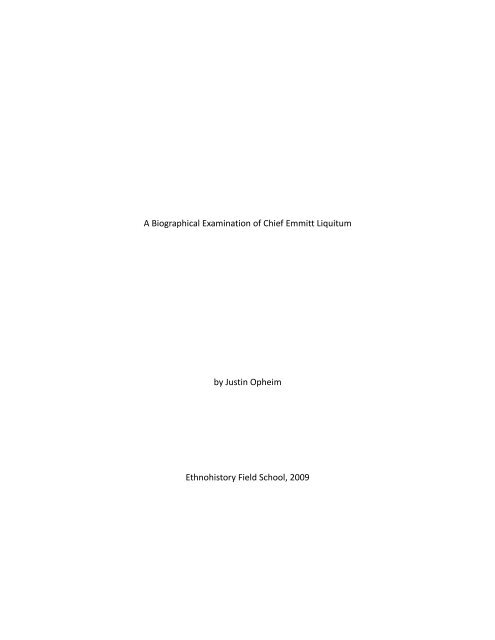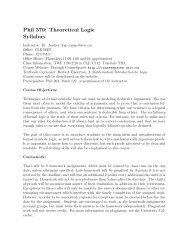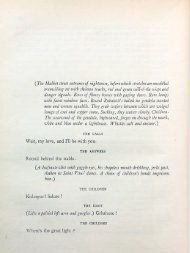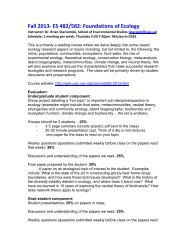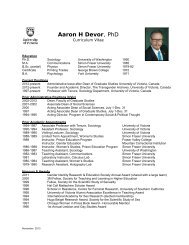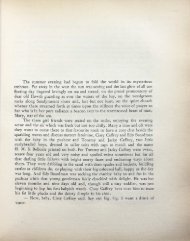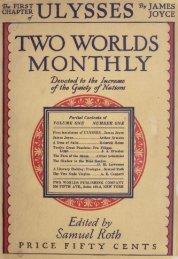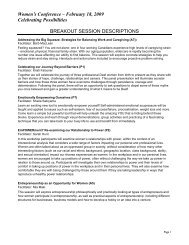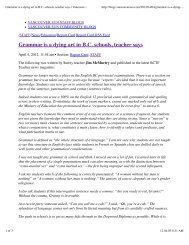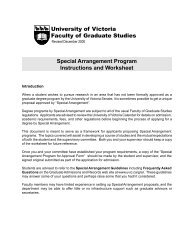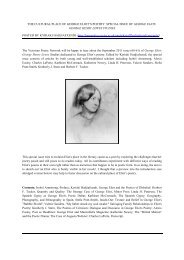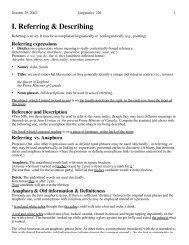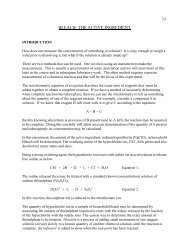A Biographical Examination of Chief Emmitt Liquitum - University of ...
A Biographical Examination of Chief Emmitt Liquitum - University of ...
A Biographical Examination of Chief Emmitt Liquitum - University of ...
You also want an ePaper? Increase the reach of your titles
YUMPU automatically turns print PDFs into web optimized ePapers that Google loves.
A <strong>Biographical</strong> <strong>Examination</strong> <strong>of</strong> <strong>Chief</strong> <strong>Emmitt</strong> <strong>Liquitum</strong><br />
by Justin Opheim<br />
Ethnohistory Field School, 2009
British Columbia’s Fraser Canyon is an example <strong>of</strong> a region that is rich in resources,<br />
culture, and heritage. It is very alive with significant and meaningful stories. For many centuries<br />
the Fraser Canyon has been the province’s primary communication and transportation corridor.<br />
It was, and continues to be, a territory <strong>of</strong> amazing bio-diversity, with a vast network <strong>of</strong> lakes and<br />
rivers. These bodies <strong>of</strong> water provide spawning habitat to millions <strong>of</strong> salmon from all six Pacific<br />
Coast species: Spring, Cutthroat, Sockeye, Pink, Coho, and Chum. In fact, the Fraser Canyon<br />
produces more salmon than any other location on earth. Millions <strong>of</strong> salmon return each year to<br />
various parts <strong>of</strong> the Fraser River system and dozens <strong>of</strong> other species <strong>of</strong> fish also inhabit the<br />
region. In addition, the Fraser Canyon contains an abundance <strong>of</strong> geographical beauty, mystical<br />
supernatural elements, and strong human memories. 1 All <strong>of</strong> these things are deserving <strong>of</strong><br />
preservation and study. In particular, the human memories and the oral and written testimony<br />
<strong>of</strong> Indigenous Peoples and their lives deserve examination and reflection. Therefore, a<br />
biographical study <strong>of</strong> the life <strong>of</strong> <strong>Chief</strong> <strong>Emmitt</strong> <strong>Liquitum</strong> is extremely useful, if not essential, due<br />
to his life heritage value for present and future generations. Such research will also serve as a<br />
tool for social justice, resource, and treaty claims in the contemporary political climate.<br />
1 Yale and Fraser Canyon Community Heritage Context Study and Heritage Strategic Plan, Fraser Valley Regional<br />
District: March 31 2009, 17.<br />
2
<strong>Chief</strong> <strong>Liquitum</strong> also known as “he stamps on something” 2 is considered the last Grand<br />
<strong>Chief</strong> and a great leader <strong>of</strong> the British Columbian Fraser Canyon People. According to primary<br />
and secondary historical sources, including pictures that were considered portraits <strong>of</strong> <strong>Chief</strong><br />
<strong>Liquitum</strong>, he was a stylish, fashionable, and charismatic Indigenous leader. Some <strong>of</strong> his<br />
distinctive markers included a ceramic pipe for smoking tobacco, a black top hat, and handsome<br />
and tidy clothing. He was a very important member <strong>of</strong> Sto:lo society before, during, and after<br />
the Fraser River gold rush <strong>of</strong> 1858. He was a key political, social, economic, and cultural figure in<br />
nineteenth century British Columbian native-newcomer relations. He was considered a Grand<br />
<strong>Chief</strong> because <strong>of</strong> the responsibility and authority that he held amongst both Indigenous People<br />
and people <strong>of</strong> European descent. He commanded the most intense attention and control over<br />
all Sto:lo people from the Lower Fraser Canyon to the Upper Fraser Canyon, including the Yale<br />
people, also known as the Tait people. The Fraser Canyon people were very diverse and held<br />
beliefs and practices that were heterogeneous. However, it is quite clear that they were all<br />
culturally similar as Sto:lo People.<br />
According to research conducted by Irene Bierky, although there were dozens <strong>of</strong><br />
individual Indigenous bands with their own tribal councils and a head chief, these head chiefs<br />
from each band all reported to Grand <strong>Chief</strong> <strong>Liquitum</strong>. 3 She describes him as the leader among<br />
leaders <strong>of</strong> a centralized Indigenous Fraser Canyon political alliance that addressed seasonal,<br />
resource, and social concerns. Importantly, she argues that visiting Indigenous Peoples<br />
2 Wilson Duff Field Notes, Books 1-4, 1950, Sto:lo Nation Archives, 48.<br />
3 Irene Bjerky, “Brief Overview: <strong>Chief</strong> <strong>Liquitum</strong> <strong>of</strong> Yale,” (Christmas, 2002) 1.<br />
3
consulted <strong>Chief</strong> <strong>Liquitum</strong> when it came to permission to explore Sto:lo traditional lands and<br />
territory. They would consult him, Bierky reports, if they desired to harvest fish, berries, goat<br />
fur, deer, timber or other natural resources from the fertile and prosperous lands <strong>of</strong> the Fraser<br />
Canyon. Prominent and significant European leaders chose to engage and talk with <strong>Chief</strong><br />
<strong>Liquitum</strong> when they wanted to work and deal with local Indigenous People. This in particular,<br />
elevated his status as an important leader <strong>of</strong> all Fraser Canyon Indigenous People. 4 He was a<br />
middle man, a conduit, a consultant, a social broker, and a conflict resolutionist between the<br />
two very different societies <strong>of</strong> Natives and Newcomers.<br />
According to historian Irene Bjerky, <strong>Chief</strong> <strong>Liquitum</strong> was recorded as Grand <strong>Chief</strong> <strong>of</strong> the<br />
Fraser Canyon in 1858, 1878 and 1888 census records, and most likely led his people for several<br />
years before and after those dates. <strong>Liquitum</strong> was in charge as a leader during decades <strong>of</strong> rapid<br />
change involving significant events, and during a time when Indigenous People constantly had<br />
to adapt to new ways <strong>of</strong> life and unfamiliar ways <strong>of</strong> knowing. At the time <strong>of</strong> <strong>Chief</strong> <strong>Liquitum</strong>’s<br />
tenure, British Columbia had just recently joined the Canadian Confederation in July <strong>of</strong> 1871.<br />
The Canadian Pacific Railway was being constructed in the province to link trade and families<br />
from East to West in Canada. In addition, this was a period <strong>of</strong> “boom and bust” economically for<br />
British Columbia. The discovery <strong>of</strong> gold in the Fraser River in the spring and summer <strong>of</strong> 1858<br />
brought mass migration from the United States in particular, California. At this time more than<br />
4 Bjerky, “Brief Overview,” 3.<br />
4
30,000 Americans 5 migrated to British Columbia’s Fraser Canyon in hopes <strong>of</strong> striking lots <strong>of</strong> gold<br />
and becoming instantly rich and wealthy beyond their dreams.<br />
In the book Spuzzum anthropologist Andrea Laforet mentions <strong>Chief</strong> <strong>Liquitum</strong>, but with a<br />
different spelling – Lekutum. She mentions him as the chief <strong>of</strong> Yale in the year 1888. According<br />
to her research, he was <strong>of</strong>ficially listed in the Indian censuses <strong>of</strong> Yale in both 1878 and 1888. 6<br />
According to historian Irene Bjerky and Sto:lo Nation archivist Tia Halstad few historical<br />
records remain describing <strong>Chief</strong> <strong>Liquitum</strong>’s personal and intimate life. Interestingly, during an<br />
interview that I had with Sto:lo Nation genealogist Alice Marwood, a document was shared that<br />
indicated that his father’s name was Sie’meiya and his mother’s name was Titita. Also, the<br />
document revealed what is apparently well known in the community, that he had a plethora <strong>of</strong><br />
wives and many children. He was <strong>of</strong>ficially married three times during his life and had <strong>of</strong>fspring<br />
with each wife. <strong>Chief</strong> <strong>Liquitum</strong> first married a woman named Lucy Lawatsat. They had one son<br />
named James Maloyheq and one daughter named Emma. Next <strong>Chief</strong> <strong>Liquitum</strong> married a<br />
woman who went by the name <strong>of</strong> Suzanne. They had three children named Tom, Cecile, and<br />
Michel. <strong>Chief</strong> <strong>Liquitum</strong>’s final marriage was on March 22 nd 1888, in what is present day Hope,<br />
British Columbia, and at that time he married a woman named Marie Margarite. They had one<br />
son known as Isaac. 7 In addition, anthropologist Wilson Duff recorded his 1950’s field note<br />
correspondences that <strong>Chief</strong> <strong>Liquitum</strong> had over ten mistresses. He suggested that with each<br />
5 Bjerky, “Brief Overview,” 2.<br />
6 Bjerky, “Brief Overview,” 1.<br />
7 Individual Report for Domonique (<strong>Chief</strong> Yale) Leakootum, Chilliwack, BC, May 4, 2009, 1.<br />
5
mistress he had between half a dozen to ten children. The mistresses came from opposite ends<br />
<strong>of</strong> the chief’s large territorial domain. Some were from Chilliwack, Spuzzum, Yale, Nicola,<br />
Spences Bridge, and even the coast. 8 Consequently, he essentially had a small dynasty <strong>of</strong><br />
descendants. The Hope family, residing in and around Yale, BC, have been genetically linked to<br />
the chief. <strong>Chief</strong> <strong>Liquitum</strong>’s remains rest in a Yale Indigenous cemetery beside both marked and<br />
unmarked graves. Upon his grave plot there rests a rusted cross with his name across it,<br />
identifying him as <strong>Emmitt</strong> <strong>Liquitum</strong>. It was once a white painted cross, as there are remnants <strong>of</strong><br />
white paint on it. It does not stand out in any way as being special when compared with the<br />
other grave markers. It presents as a rather humble resting space for such an influential and<br />
revered Indigenous leader <strong>of</strong> the Fraser Canyon. 9<br />
It appears that <strong>Chief</strong> <strong>Liquitum</strong> arranged for his chieftainship to be passed on hereditarily<br />
to one <strong>of</strong> his sons, who would succeed him and remain chief for a substantial amount <strong>of</strong> time,<br />
well into the turn <strong>of</strong> the twentieth century. This individual was known as <strong>Chief</strong> James <strong>of</strong> Yale. He<br />
was a very outspoken key figure in the realm <strong>of</strong> advocating for Indigenous rights. Unlike his<br />
father <strong>Chief</strong> James was inscribed and documented in a multiplicity <strong>of</strong> <strong>of</strong>ficial and un<strong>of</strong>ficial<br />
written sources <strong>of</strong> the time. He is mentioned most frequently in Department <strong>of</strong> Indian Affairs<br />
(DIA) and Royal Commission records. <strong>Chief</strong> James <strong>of</strong> Yale was heavily involved with the Royal<br />
Commission <strong>of</strong> 1914. This commission began an investigation after a railway blasting for the<br />
CNR Company caused a rockslide at Hell’s Gate. This environmental disaster blocked <strong>of</strong>f the river<br />
8 Wilson Duff Field Notes, 49.<br />
9 Bjerky, “Brief Overview,” 3.<br />
6
in the area causing severe damage to important salmon runs. However, knowledge <strong>of</strong> <strong>Chief</strong><br />
James’ personal and family life remains sparse in historical sources, not unlike his father <strong>Chief</strong><br />
<strong>Liquitum</strong>. But documents such as those <strong>of</strong> the British Columbia census records demonstrate<br />
that <strong>Chief</strong> James was chieftain in 1901. There were also many citations <strong>of</strong> him in the DIA records<br />
between the years 1897 through 1913. He passed away in Yale, British Columbia at age 91 in the<br />
year 1922. 10 Importantly, although <strong>Chief</strong> James succeeded his father <strong>Chief</strong> <strong>Liquitum</strong>, he was not<br />
a grand chieftain. He appeared only to hold major influence in the region <strong>of</strong> Yale, not<br />
throughout the entire Fraser Canyon as his father had done. Thus, <strong>Chief</strong> <strong>Liquitum</strong>’s leadership<br />
tenure marked the end <strong>of</strong> the “grand chief” era.<br />
Archaeologist David Schaepe argues in a similar way to Irene Bjerky regarding <strong>Chief</strong><br />
<strong>Liquitum</strong>. He suggests that this great man was vital to socio-political organizations, political<br />
economies, social networks, and the cultural identity <strong>of</strong> all Fraser Canyon Indigenous Peoples.<br />
No other chief in the vicinity <strong>of</strong> the upper and lower Fraser River commanded such respect and<br />
traditional centralized leadership. Schaepe points out that prior to the smallpox epidemic <strong>of</strong><br />
1782, Sto:lo Peoples population levels were abundant and healthy, with both young and elderly,<br />
but that after the disease epidemic and contact with Europeans it was decimated and reduced<br />
to the mere hundreds. As a consequence <strong>of</strong> this tragedy, David Schaepe suggests that rarely did<br />
“chiefdom-level authority extend beyond the household and across local villages.” 11 Therefore, it<br />
10 Bjerky, “Brief Overview,” 12.<br />
11 David M. Schaepe, “Rock Fortifications: Archaeological Insights Into Pre-Contact Warfare And Sociopolitical<br />
Organization Among The Sto:lo Of The Lower Fraser River Canyon, B.C.,” Society for American Archaeology 71<br />
(2006) 672.<br />
7
demonstrates yet another obstacle that the future <strong>Chief</strong> <strong>Liquitum</strong> would have overcome only a<br />
few decades later.<br />
Importantly, <strong>Chief</strong> <strong>Liquitum</strong> not only held the support <strong>of</strong> the upper caste elite Indigenous<br />
Peoples, he was also popular and was supported by the warrior and military class, who were <strong>of</strong><br />
critical strategic importance when diplomacy failed or when coastal raiders such as the Haida or<br />
Cowichan Peoples attacked. The issue <strong>of</strong> the importance <strong>of</strong> the warrior class to <strong>Chief</strong> <strong>Liquitum</strong><br />
has been a point <strong>of</strong> historical discussion. For example, cultural liaison for the Sto:lo Nation,<br />
Albert Sonny McHalsie, suggests that the Fraser Canyon People were not known for their<br />
military prowess, and gave higher status to knowledge and teaching. In contrast, Dr. Daniel<br />
Marshall <strong>of</strong> the <strong>University</strong> <strong>of</strong> Victoria has argued that Upper Fraser Canyon People such as the<br />
Thompson and Yale were instrumental in the Fraser River War <strong>of</strong> 1858. He has asserted that had<br />
it not been for the support <strong>of</strong> the Indigenous population, then American “manifest destiny”<br />
and its 30,000 migrant gold miners would have usurped British Columbia and altered<br />
geographical boundaries between Canada and the United States dramatically. Regardless <strong>of</strong><br />
Sonny McHalsie and Dr. Daniel Marshall’s differing interpretations there certainly was a warrior<br />
culture in existence among the Fraser Canyon People, and their support <strong>of</strong> the leadership was<br />
essential. The Sto:lo word for warrior is Sto:mex. However it is a complicated word because it<br />
has a variety <strong>of</strong> meanings and connotations. It could mean a “hot-headed” and impulsive man<br />
or a “war leader.” As a result, the socio-political standing <strong>of</strong> warrior and military men could<br />
range from low to medium to high status. Significantly, their status in society depended upon<br />
8
their personal characteristics such as their actions, spirit power, and their given genealogical<br />
name. 12<br />
In light <strong>of</strong> this information, it is important to note that <strong>Chief</strong> <strong>Liquitum</strong> was a master<br />
diplomat not averse to engaging in Machiavellian tactics. He took it upon himself to maintain<br />
peace, harmony, and balance amongst his own people at all cost. Putting to death a high status<br />
leader or their relative(s) who were deviant was rare, however it did occasionally occur in the<br />
nineteenth century. For example, <strong>Chief</strong> <strong>Liquitum</strong> did have two brothers who were perpetual<br />
“trouble-makers” and who had tense relations with other Indigenous Peoples. There are several<br />
such documented accounts <strong>of</strong> him conspiring in political assassination, in order to maintain<br />
diplomatic harmony, in the Sto:lo history book entitled, You Are Asked To Witness, edited by Dr.<br />
Keith Thor Carlson <strong>of</strong> the <strong>University</strong> <strong>of</strong> Saskatchewan. Apparently, in the first high tension<br />
scenario, one <strong>of</strong> <strong>Chief</strong> <strong>Liquitum</strong>’s brothers shot at fisherman from a nearby village who was<br />
peacefully attempting to load up his dried salmon stocks into his canoe from his fishing plot.<br />
<strong>Liquitum</strong>’s brother missed and the fisherman shot back killing him instantly. Once <strong>Chief</strong><br />
<strong>Liquitum</strong> got news <strong>of</strong> how and why his brother died, he was accepting <strong>of</strong> the fact that his<br />
brother had been silenced via violent force. In another account, two <strong>of</strong> <strong>Liquitum</strong>’s brothers had<br />
been raiding and stealing things up and down the Fraser Canyon. This upset a large number <strong>of</strong><br />
villages in the Canyon. Consequently, <strong>Chief</strong> <strong>Liquitum</strong> arranged for an ambush assassination <strong>of</strong><br />
his only remaining living brother, who had survived the multiple raids. He was terminated by a<br />
sharp-shooter from Hope while canoeing down an unspecified lake. 13<br />
12 David M. Schaepe “Rock Fortifications,” 678.<br />
9
If indeed there was a centralized political leadership under Grand <strong>Chief</strong> <strong>Liquitum</strong>, the<br />
effective supervision and running <strong>of</strong> a canyon wide military defensive protection network must<br />
have been complex. It would have required a level <strong>of</strong> licence and collective governance beyond<br />
that generally found among Northwest Coast Indigenous communities. David Schaepe argues<br />
that Sto:lo oral history provides some support for the existence <strong>of</strong> a broad-based system <strong>of</strong><br />
leadership in this region. This has been determined via past and present oral interviews with<br />
Indigenous people like Sonny McHalsie, Patrick Charlie, and Mary Charles. 14 Like Irene Bjerky<br />
demonstrates, these people have indicated that <strong>Chief</strong> <strong>Liquitum</strong> was the name <strong>of</strong> the main<br />
“head-man” <strong>of</strong> the Fraser Canyon People who lived in the mid to late nineteenth century. In<br />
other words, evidence suggested that:<br />
Liquitem lived in a village near Yale that was considered the main headquarters from<br />
here to Maria Slough in the Central Fraser Valley, coincident with the Teit tribal area.<br />
In each tribe, [there was] one main leader. Head governor <strong>of</strong> that tribe. Also [a] village<br />
headman. Whatever happened there was reported to [the] main leader...Liquitem was<br />
headman over 60 years. The old chief at Yale was the boss <strong>of</strong> the whole river and there<br />
were subsidiary chiefs all along the Fraser. 15<br />
<strong>Liquitum</strong> was a famous chief by historical standards. It is known that his cousin was chief<br />
before him, but that he was not nearly as influential and charismatic. According to interview<br />
13 Keith Thor Carlson, You Are Asked To Witness: The Sto:lo in Canada’s Pacific Coast History (Chilliwack, BC: Sto:lo<br />
Heritage Trust, 1997), 94.<br />
14 David M. Schaepe “Rock Fortifications,” 700.<br />
15 David M. Schaepe “Rock Fortifications,” 701.<br />
10
transcripts with Patrick Charlie via anthropologist Wilson Duff, Indigenous people went to <strong>Chief</strong><br />
<strong>Liquitum</strong> whenever there were concerns with colonial governor James Douglas. When it came<br />
to serious military matters and the defending <strong>of</strong> resources, such as wind dried salmon stocks<br />
from Coastal Salish Peoples, <strong>Chief</strong> <strong>Liquitum</strong> could always call on volunteers and reserves <strong>of</strong> men<br />
from neighbouring villages or down and up river to take up arms. The chieftain level<br />
governance, with Grand <strong>Chief</strong> <strong>Liquitum</strong> at the top <strong>of</strong> the bureaucracy, likely operated on a<br />
priority or seasonal basis and was more active at some points and less active at others. For<br />
example, it was likely more influential and utilized during times <strong>of</strong> higher instances <strong>of</strong> raiding<br />
and skirmishing activity for food stuffs and slaves. 16<br />
It is important to note that there were both s’mela:th (high status communities) and<br />
s’texem (low class communities) that <strong>Chief</strong> <strong>Liquitum</strong> directed and governed. The s’mela:th<br />
villages were fundamental to the political economy and strategic protection <strong>of</strong> the Fraser<br />
Canyon People. There was also much interconnectedness with other villages and bands via<br />
blood and marriage relationships. The s’texem communities were <strong>of</strong>ten social units that were<br />
unattached and more isolated from the centre <strong>of</strong> Sto:lo politics, resources, economy, and<br />
culture. They <strong>of</strong>ten had a higher concentration <strong>of</strong> foreigners and enslaved people. 17<br />
During this time <strong>of</strong> rapid social change, flux, and raiding, the Fraser Canyon Peoples also<br />
had to contend with colonialism that had the most pr<strong>of</strong>ound impact on their societies. Together,<br />
both Western forms <strong>of</strong> state and religion engaged in the “peaceful” subordination <strong>of</strong> Indigenous<br />
societies. They tried to promote the dissolution <strong>of</strong> long-standing Indigenous institutions that<br />
16 David M. Schaepe “Rock Fortifications,” 700.<br />
17 David M. Schaepe “Rock Fortifications,” 700.<br />
11
had been around since the dawn <strong>of</strong> time. The hegemonic and coercive state was placing Fraser<br />
Canyon People onto “increasingly small and foreign social and geopolitical landscapes.” 18 For<br />
example, they tried to create divisions and in-fighting between Fraser Canyon People by dividing<br />
them into over two dozen 19 separate and isolated bands on separate plotted reserves.<br />
Mrs Lena Hope <strong>of</strong> Yale provided some crucial oral testimony to past researcher Oliver<br />
Wells in the fall <strong>of</strong> 1967 regarding <strong>Chief</strong> <strong>Liquitum</strong>. She referred to the chief with an alternate<br />
spelling; Loyoxweten. She suggested in her interview that <strong>Liquitum</strong> had lived to a very old age,<br />
being a centurion, and that he died peacefully <strong>of</strong> natural causes. Importantly, and similar to<br />
Irene Bjerky, she mentioned that one <strong>of</strong> his signature features was the utilization <strong>of</strong> a “long<br />
ceramic tobacco pipe” and that he had long hair that was almost completely white. Lena Hope<br />
recalled assisting the old chief with daily care when she was around the ages <strong>of</strong> eight and nine.<br />
She would give him food and drink, fill his pipe with tobacco, and watch over him when he was<br />
sickly. Unfortunately, although she had asserted that he was a centurion, she could not<br />
remember on what day, month and year he passed away. 20 In addition, Lena Hope provided<br />
evidence that a plethora <strong>of</strong> Fraser Canyon People were intimately connected as one via travel,<br />
marriage, and <strong>of</strong>fspring. She explained to Oliver Wells that, “Some <strong>of</strong> them I guess go<br />
somewhere – get married and go where their husbands are or something.” 21 She asserted that<br />
these inter-village and geopolitical marriages were <strong>of</strong> the utmost importance to Fraser Canyon<br />
18 David M. Schaepe “Rock Fortifications,” 700.<br />
19 David M. Schaepe “Rock Fortifications,” 700.<br />
20 Lena Hope, Interview with Oliver Wells, 28 September 1967, 661.<br />
21 Lena Hope, Interview, 663 .<br />
12
People. So much so that grooms would try to cement a marriage and impress the bride’s family<br />
via a large and handsome dowry. 22<br />
As mentioned earlier <strong>Chief</strong> <strong>Liquitum</strong> was grand chief during turbulent and changing<br />
times. British Columbia was “boom and bust” economically via the Fraser River gold rush that<br />
also culminated into the Fraser River War in the spring and summer <strong>of</strong> 1858. This conflict over<br />
resources, mining sites, settlement, trade, and small business was one <strong>of</strong> the longest and most<br />
violent in Canadian history. In addition, it occurred right in the territory that <strong>Chief</strong> <strong>Liquitum</strong> was<br />
a main leader and stakeholder. Unfortunately, the vast majority <strong>of</strong> primary and secondary<br />
sources on this topic have glorified and over-emphasized the role <strong>of</strong> <strong>Chief</strong> Spintlum <strong>of</strong> Lytton,<br />
while neglecting the role <strong>of</strong> <strong>Chief</strong> <strong>Liquitum</strong> (chief <strong>of</strong> Yale) in this dramatic and historic event. 23<br />
Over the course <strong>of</strong> 1858 approximately 30,000 American miners, as well as European<br />
and Chinese miners, converged on the Fraser River with a strong desire and yearning for the<br />
discovery <strong>of</strong> gold. However, shortly after their arrival, some miners violated and raped<br />
Indigenous women. In retaliation, Indigenous warriors surprise attacked several American and<br />
French miners and killed them. To cause further agitation and rift with non-Indigenous miners<br />
they decapitated their victims and tossed their bloody remains into the Fraser River. As a result,<br />
Native-Newcomer violence escalated to the point that both parties attacked each other’s<br />
settlements and homes. Mortuary sites were burned and defiled. In the absence <strong>of</strong> British<br />
colonial authority, the Fraser Canyon territories more closely resembled the American Western<br />
22 Lena Hope, Interview, 664.<br />
23 Lewis J. Swindle, The Fraser River Gold Rush <strong>of</strong> 1858: As Reported by the California Newspapers <strong>of</strong> 1858<br />
(Victoria, Canada: Trafford Publishing, 2001), 289.<br />
13
Frontier than the rest <strong>of</strong> British North America. The expansive numbers <strong>of</strong> foreign miners had<br />
effectively taken to vigilante and “eye for an eye” justice. 24<br />
A primary source colonial correspondence written by Captain H.M. Snyder to Governor<br />
James Douglas during the Fraser River War <strong>of</strong> 1858 in the month <strong>of</strong> August, gave a Eurocentric<br />
view <strong>of</strong> the conflict. Importantly, Captain Snyder provided possible admissible evidence that<br />
may be a description <strong>of</strong> <strong>Chief</strong> <strong>Liquitum</strong> during his campaign. Captain Snyder was a<br />
democratically elected militia captain <strong>of</strong> a company <strong>of</strong> about six dozen militant European<br />
descent miners from various nations. Over the course <strong>of</strong> the latter half <strong>of</strong> August his company<br />
attempted to make peace with various Indigenous chiefs and tribal councils along the Fraser<br />
River. Although the exact date was unknown, at one point Captain Snyder made reference to a<br />
very cool and calculating Indigenous chief that seemed to hold the attention <strong>of</strong> mass audiences<br />
with the words he had spoken; a great chief <strong>of</strong> peace and a respected leader among his people.<br />
Captain Snyder went on to say that, “Here in the presence <strong>of</strong> them, we made a treaty <strong>of</strong> peace<br />
with them and after stating our object they appeared to be highly delighted with what we had<br />
proposed to them. The chief sent his son with us and two other Indians.” 25 Interestingly, if this<br />
was indeed <strong>Chief</strong> <strong>Liquitum</strong>, he probably agreed to a treaty because not abiding to Captain<br />
Snyder’s terms likely would have meant major bloodshed and the loss <strong>of</strong> many <strong>of</strong> his people.<br />
Ironically, while Captain Snyder boastfully suggested in his correspondence that he had achieved<br />
peace without killing, he forgot to mention that he did use intimidation and force to make the<br />
24 Daniel P. Marshall, “The Fraser War: H.M. Snyder, Captain <strong>of</strong> the Pike Guards and Commander <strong>of</strong> Company, to<br />
James Douglas, Governor <strong>of</strong> Vancouver Island, 28 August 1858,” Native Studies Review (Summer 1996) 1.<br />
25 Daniel P. Marshall, “The Fraser War,” 2.<br />
14
Indigenous People concede to his terms. For example, his militia was highly armed with muskets<br />
and other projectiles and his militia was reinforced by an Austrian Militia Company as well as by<br />
other angry and armed miners.<br />
In comparison to other militias, Captain Snyder’s militia was more balanced and less<br />
aggressive. The Austrian militia Company wanted to kill every child, woman, and man that had<br />
Indigenous blood, whether full or partial. Fortunately, in his letter, Captain Snyder demonstrated<br />
emotions <strong>of</strong> compassion and a strong desire not to engage in genocide and the killing <strong>of</strong><br />
innocent Indigenous Peoples. 26 Lastly, and importantly, it was not only miners <strong>of</strong> European<br />
descent who were negatively affecting <strong>Chief</strong> <strong>Liquitum</strong>, <strong>Chief</strong> Spintlum, and other Indigenous<br />
societies in the Fraser Canyon. The Chinese too were “suspected <strong>of</strong> being partly the means <strong>of</strong><br />
difficulty with the Indians.” 27 Many poor Chinese migrated from Southern China directly to<br />
British Columbia to work, or came to British Columbia via California, and in particular from San<br />
Francisco, to find their fortune in gold or work on the rail lines and in other resource and service<br />
sectors.<br />
The conflict <strong>of</strong> the Fraser River War had a fundamentally harmful impact on <strong>Chief</strong><br />
<strong>Liquitum</strong>’s People and their way <strong>of</strong> life. The Fraser Canyon People were a fisher people relying<br />
heavily on natural resources from rivers, streams, and the ocean. The Native-Newcomer conflict<br />
would have played havoc with the salmon fishing that year. The spring and summer months, in<br />
particular August (when Captain Snyder’s correspondence was written) and September were<br />
typically crucial months for spearing and netting fish. Instead, in 1858, those months were spent<br />
26 Daniel P. Marshall, “The Fraser War,” 3.<br />
27 Daniel P. Marshall, “The Fraser War,” 4.<br />
15
skirmishing or peace negotiating with angry and militant gold crazed miners. In addition, the<br />
fighting that occurred prior to peace-making resulted in the destruction <strong>of</strong> Indigenous wind<br />
dried salmon stocks, their fishing sites, and their own huts and village communities. Even<br />
though Yale was the site <strong>of</strong> a large summer fishery, all the turmoil would have resulted in little<br />
time to replace lost stores <strong>of</strong> wind dried salmon and other food stuffs. 28<br />
Fortunately, due to the hard work and diplomatic efforts <strong>of</strong> both Indigenous and non-<br />
Indigenous leaders like Captain H.M. Snyder and <strong>Chief</strong> <strong>Liquitum</strong>, permanent disaster and war<br />
were halted. For example:<br />
Significantly though, the cross-racial peace treaties that were subsequently negotiated<br />
Between some <strong>of</strong> the more judicious miners like Captain H.M. Snyder, and more<br />
accommodating Aboriginal leaders like <strong>Liquitum</strong> <strong>of</strong> Yale and Spintlum <strong>of</strong> Lytton, were<br />
settled and implemented without external colonial government intervention...the<br />
Nlaka’pamux Palek (Thompson River People), and the Sto:lo Slumack, still echo in the<br />
Fraser Canyon today as people today discuss this tumultuous period in history. 29<br />
Ironically, had it not been for the agency <strong>of</strong> Indigenous Peoples in the first place, the<br />
European miners would not have been able to extract gold from the Fraser River. This was<br />
because Indigenous men and women acted as guides, packers <strong>of</strong> freight, miners, and rescuers <strong>of</strong><br />
foreign miners in canoeing accidents. The American miners heavily relied on <strong>Chief</strong> <strong>Liquitum</strong>’s<br />
28 Andrea Lynne Laforet, “Folk History in a Small Canadian Community” (M.A. thesis., <strong>University</strong> <strong>of</strong> British<br />
Columbia, 1974), 81.<br />
29 Yale and Fraser Canyon Community Heritage Context Study and Heritage Strategic Plan, 19.<br />
16
Indigenous People to help them reach and properly exploit the gold resources in the Fraser<br />
River region. 30<br />
<strong>Chief</strong> <strong>Liquitum</strong> was a great leader and diplomat. He was involved in many political,<br />
economic, social, cultural, and strategic issues that affected the Fraser Canyon People in his<br />
territorial domain. He was not hesitant to deal with White politicians like James Douglas or<br />
more common men like groups <strong>of</strong> foreign miner militia companies like the one under the<br />
command <strong>of</strong> Captain H.M. Snyder. He exercised rational, intuitive, and sincere power and<br />
decision making. According to anthropologist Wilson Duff he even petitioned the “Great White<br />
Mother” in England when his concerns were not being addressed locally. “Lye’kwetem was a<br />
famous Yale chief that went to see King George III.” 31 According to Sto:lo Nation cultural liaison<br />
Albert (Sonny) McHalsie, <strong>Chief</strong> <strong>Liquitum</strong> was instrumental in the treaty and land process. He<br />
helped to get the Seabird Island Reserve for many <strong>of</strong> his displaced upriver Fraser Canyon People<br />
who had been marginalized to the periphery by discriminatory state policies. 32<br />
Today the Fraser Canyon People are divided into over two dozen fragmentary bands.<br />
While there are five independent bands, including the Yale Band, the vast majority belong to<br />
one <strong>of</strong> two political alliances; either Sto:lo Nation or Sto:lo Tribal Council. They are in difference<br />
<strong>of</strong> opinion over how to go about the treaty process, as well as who has rights and ownership to<br />
various natural resources whether they be salmon fisheries, logging rights, or berry patches.<br />
30 Laforet, “Folk History in a Small Canadian Community,” 82.<br />
31 Wilson Duff Field Notes, 47.<br />
32 Albert Sonny McHalsie, personal interview, 19 May 2009, 2.<br />
17
The study <strong>of</strong> <strong>Chief</strong> <strong>Liquitum</strong> is important and relevant because it demonstrates a time when all<br />
Fraser Canyon People were somewhat united as one and at least made attempts at communal<br />
and collective decision making both socially and economically. Although destructive<br />
government policies pit differing Indigenous bands against one another and harmed their social<br />
fabric, now is the time for healing and peace-making among Fraser Canyon People themselves.<br />
They must engage in the same sort <strong>of</strong> diplomacy and goals that <strong>Chief</strong> <strong>Liquitum</strong> had in mind for<br />
his people less than two-hundred years ago.<br />
18
Bibliography<br />
Allard, Jason O. “Reminiscences,” n.d., E/C/A15, BC Archives<br />
Bjerky, Irene. “Brief Overview: <strong>Chief</strong> <strong>Liquitum</strong> <strong>of</strong> Yale.” (Christmas, 2002): 1-12.<br />
Boas, Dr. Frank. First General Report on the Indians <strong>of</strong> British Columbia. 1889.<br />
Carlson, Keith Thor. “The Power <strong>of</strong> Place the Problem <strong>of</strong> Time: A Study <strong>of</strong> History<br />
and Aboriginal Collective Identity.” Ph.D. diss, <strong>University</strong> <strong>of</strong> British Columbia,<br />
2003.<br />
Carlson, Keith Thor. You Are Asked To Witness: The Sto:lo in Canada’s Pacific Coast<br />
History. Chilliwack, British Columbia: Sto:lo Heritage Trust, 1997.<br />
Duff, Wilson. Field Notes, Books 1-4. 1950. Sto:lo Nation Archives.<br />
Hope, Lena. Interview with Oliver Wells, 28 September 1967.<br />
Individual Report for Dominique (<strong>Chief</strong> Yale) Leakootum. Chilliwack, BC: 04 May 2009.<br />
Laforet, Andrea Lynne. “Folk History in a Small Canadian Community.” M.A. thesis,<br />
<strong>University</strong> <strong>of</strong> British Columbia, 1974.<br />
19
Marshall, Daniel P. “The Fraser War: H.M. Snyder, Captain <strong>of</strong> the Pike Guards and Commander<br />
<strong>of</strong> Company, to James Douglas, Governor <strong>of</strong> Vancouver Island, 28 August 1858.” Native<br />
Studies Review (Summer 1996): 1-8.<br />
McHalsie, Albert Sonny. Personal Interview, 19 May 2009.<br />
McKelvie, Bruce Alistair, Papers, MS – 0001, BC Archives<br />
Pat, Frank. Interview with Albert Phillips, March 1978.<br />
Schaepe, David M. “Rock Fortifications: Archaeological Insights Into Pre-Contact Warfare And<br />
Sociopolitical Organization Among The Sto:lo Of The Lower Fraser River Canyon, B.C..”<br />
Society for American Archaeology 71(2006): 671-705.<br />
Swindle, Lewis J. The Fraser River Gold Rush <strong>of</strong> 1858: As Reported by the California<br />
Newspapers <strong>of</strong> 1858. Victoria, Canada: Trafford Publishing, 2001.<br />
Wells, Oliver. Field Notes, Bob Joe and Richard Malloway. 1966/1970. Tzeachten Band,<br />
(copies at Sto:lo Nation Archives).<br />
Yale and Fraser Canyon Community Heritage Context Study and Heritage Strategic Plan. Fraser<br />
Valley Regional District: 31 March 2009.<br />
20


